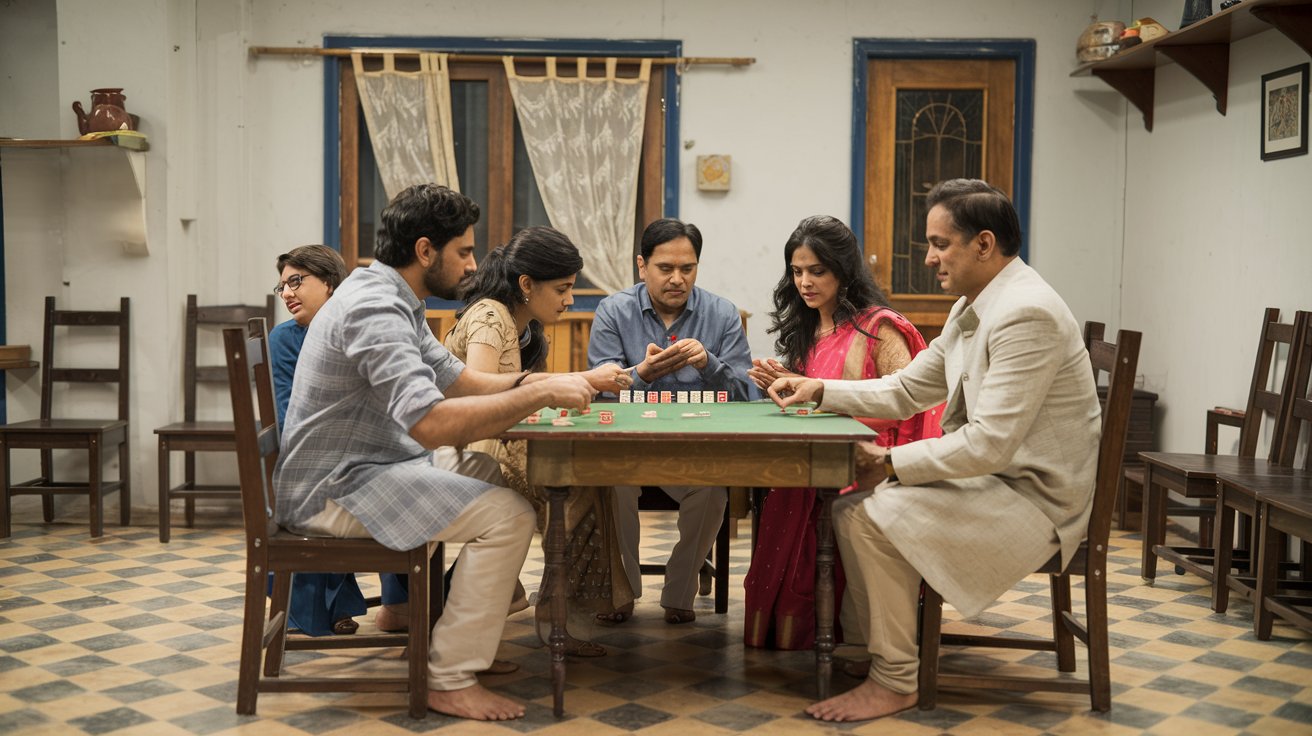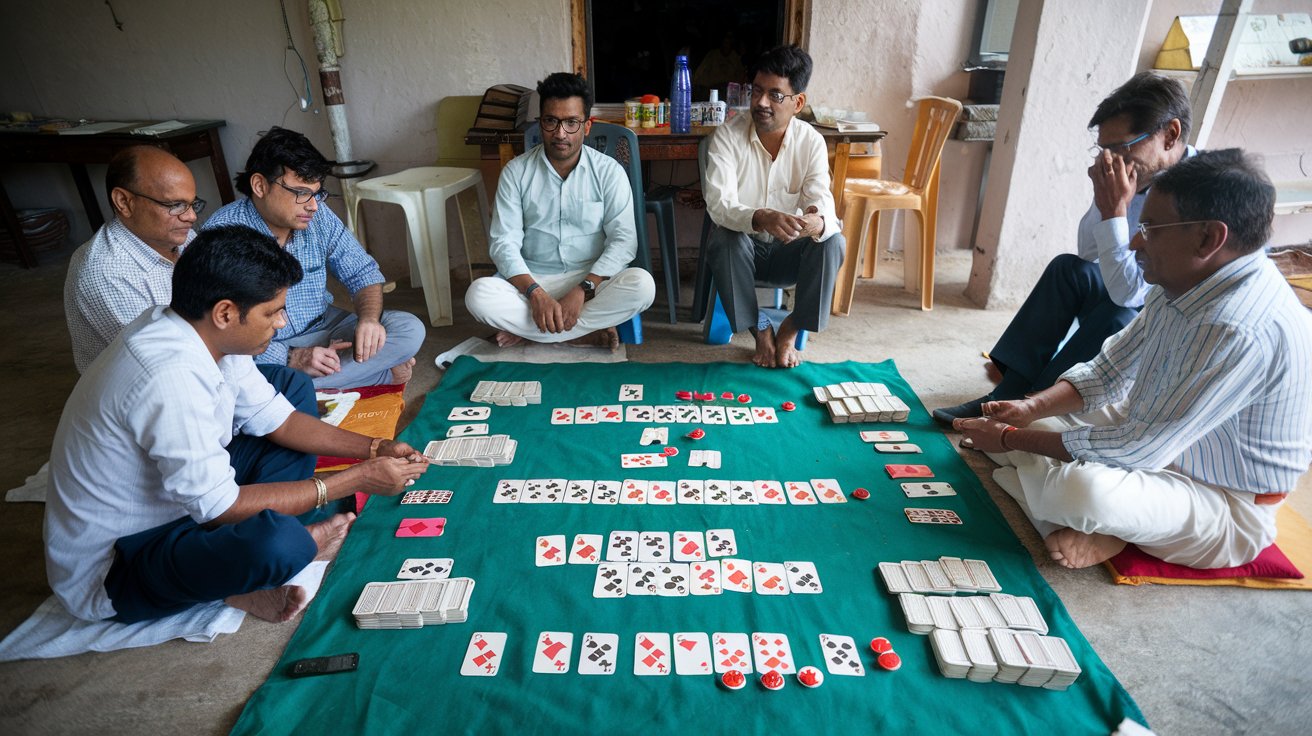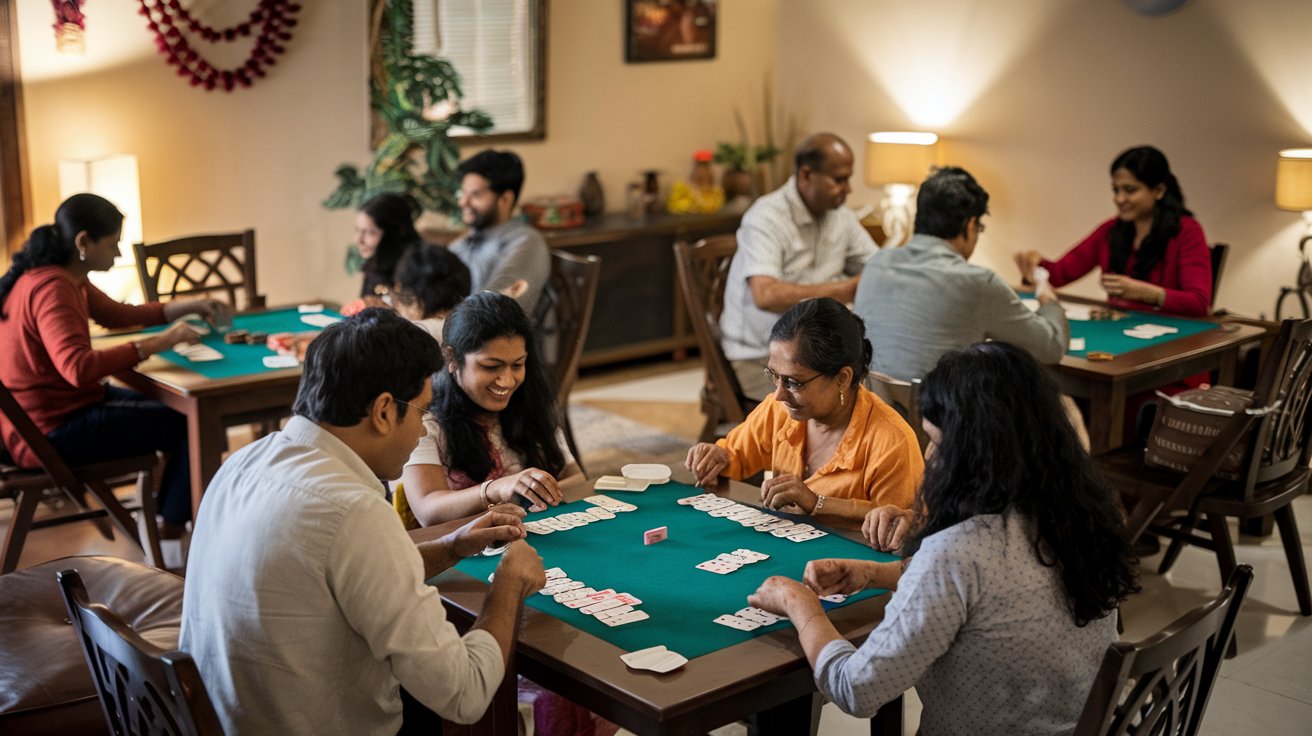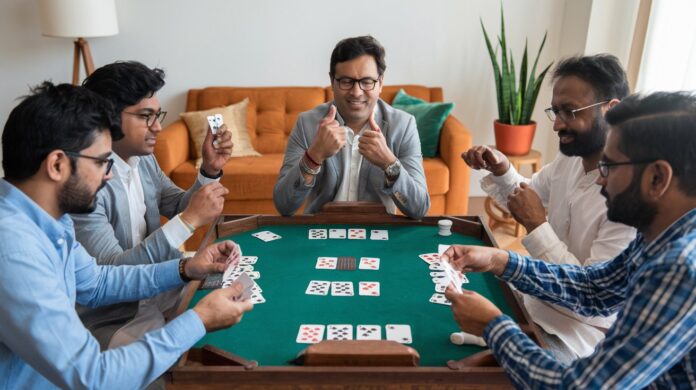Walk into any Indian household during a festival, family gathering, or lazy weekend afternoon, and chances are you’ll find a group huddled around a table, deeply engrossed in a game of rummy. The rhythmic shuffle of cards, the strategic pauses, the occasional triumphant declarations of “show” – these have become integral sounds in the soundtrack of Indian family life. Rummy has transcended its status as a mere card game to become a cultural institution, woven into the fabric of Indian households across generations and geographies.
But how did this happen? How did a card game, with roots stretching back to foreign shores, establish itself so firmly in Indian homes? This comprehensive exploration traces the fascinating journey of rummy’s evolution from an imported novelty to a beloved household tradition that bridges generational gaps, strengthens family bonds, and continues to adapt in our digital age.
As we shuffle through the history, cultural significance, and evolution of rummy in India, we’ll discover not just the story of a card game’s popularity, but a reflection of India’s own social dynamics, family values, and adaptability to changing times.
The Historical Journey of Rummy in India
Ancient Roots and Colonial Introduction

The exact origins of rummy in India are intertwined with the country’s colonial history. While card games have existed in India since ancient times – with references to games like Krida-patram dating back to medieval periods – the modern rummy we recognize today likely arrived with European colonizers.
British officers stationed in India during the colonial era brought their card games with them, introducing variants of rummy to the local population in the 19th and early 20th centuries. The game’s relatively simple rules combined with its perfect balance of skill and chance made it accessible to people across different educational backgrounds and social classes.
Historical records suggest that by the early 1900s, rummy had already begun to spread beyond colonial circles and into Indian society. The game’s adaptability was key to its adoption – it could be played with standard Western playing cards, which were becoming increasingly available, or adapted to traditional Indian card decks in some regions.
Post-Independence Popularity Surge
After India gained independence in 1947, many colonial pastimes faded from popularity, but rummy experienced the opposite trajectory. The post-independence era saw a significant surge in rummy’s popularity across Indian households for several reasons:
- Accessibility: Unlike many other games that required special equipment or venues, rummy needed only a deck of cards, making it accessible to families across economic backgrounds.
- Family-Friendly Nature: In a society where family-centered activities were highly valued, rummy provided entertainment that could include members across generations.
- Skill Development: Parents and grandparents recognized the game’s ability to teach mathematical calculations, pattern recognition, and strategic thinking, particularly to younger players.
By the 1960s and 70s, rummy had firmly established itself as a staple in many Indian households, particularly during festivals like Diwali when card playing was considered auspicious.
Cultural Integration and Regional Variations
Rummy in Indian Festivals and Celebrations
One of the most fascinating aspects of rummy’s integration into Indian culture is its association with festivals and celebrations. Diwali, the festival of lights, has perhaps the strongest connection to card games, including rummy. Playing cards during Diwali is considered an invocation of Lakshmi, the goddess of wealth and prosperity.
This tradition stems from the belief that Goddess Parvati played dice with Lord Shiva on Diwali and declared that whoever gambled on this day would prosper throughout the year. While initially, this led to gambling games, many families adapted the tradition to include skill-based card games like rummy, which provided the festive spirit without the problematic aspects of pure gambling.
Beyond Diwali, rummy has become a standard feature at weddings, where extended families gather and often engage in friendly card games during downtime between ceremonies. It serves as an excellent ice-breaker between different family groups coming together for the celebration.
Regional Variants Across India
As rummy spread throughout the subcontinent, it naturally evolved into regional variants that reflected local preferences and cultural nuances:
Indian Rummy (Paplu)
The most widely played variant across Indian households, Paplu typically uses two decks with jokers and follows a 13-card format. This version has become the standard in most North and Central Indian states.
Points Rummy
Popular in South Indian states like Kerala, Karnataka, and Tamil Nadu, Points Rummy assigns specific point values to cards and is played at a faster pace, often with money at stake (though usually nominal amounts in family settings).
Marriage Rummy
Common in Western India, particularly in Gujarat and Maharashtra, this variant requires players to form specific combinations called “marriages” (such as King and Queen of the same suit) alongside the standard sequences and sets.
Deals Rummy
Prevalent in Andhra Pradesh and Telangana, Deals Rummy involves a predetermined number of deals, with the winner being the player with the lowest points at the conclusion.
These regional adaptations demonstrate how the game has been molded to suit local sensibilities while maintaining its core appeal. Each variant adds to the rich tapestry of rummy culture in India, creating a shared yet diverse gaming tradition.
Social Dynamics: Rummy as a Family Binding Force

Intergenerational Connections
Perhaps one of the most significant factors behind rummy’s enduring popularity in Indian households is its ability to bridge generational gaps. In a traditional Indian family setup, where multiple generations often live under one roof, finding activities that appeal across age groups can be challenging.
Rummy elegantly solves this problem. Grandparents, parents, and children can all participate on relatively equal footing. The game creates rare moments where family hierarchies temporarily dissolve, replaced by the democratic rules of the game. A teenager can legitimately triumph over the family patriarch in a well-played hand, creating moments of joy and good-natured competitive spirit.
Many Indians recall learning rummy at the feet of grandparents or elder relatives, creating cherished memories and traditions that pass down through generations. These early experiences often establish rummy as a comfort activity associated with family togetherness and belonging.
Gender Inclusivity in Traditional Settings
Another notable aspect of rummy’s cultural integration is its gender-inclusive nature, especially significant in the context of traditional Indian society where many recreational activities were gender-segregated. Unlike outdoor sports or certain other games that were historically male-dominated, rummy welcomed female participation from early on.
In many households, women who might have had limited recreational options outside the domestic sphere found in rummy an acceptable and enjoyable pastime. Evening rummy circles became spaces where women could socialize, demonstrate skill, and enjoy competitive play within culturally comfortable boundaries.
This inclusivity helped cement rummy’s place in family life, as it offered entertainment that didn’t exclude any family members based on gender or physical ability. The card table became a microcosm of family unity, where everyone from the grandmother to the youngest adult could participate equally.
Economic Aspects: From Casual Play to Monetary Stakes
The Tradition of Diwali Gambling
While rummy is predominantly played as casual entertainment in Indian households, its association with monetary stakes has deep cultural roots, particularly during Diwali. The tradition of playing “teen patti” (Indian poker) and rummy for money during this festival stems from the belief that gambling on Diwali brings prosperity in the coming year.
In many households, this manifests as token gambling – small, affordable stakes that add excitement without causing financial strain. Family rummy sessions during Diwali might involve each player contributing a modest amount to a prize pool, with winners taking home nominal prizes. This practice transforms rummy from mere entertainment into a ritualistic activity connected to prosperity and good fortune.
Rummy Clubs and Social Circuits
Beyond the family setting, rummy’s popularity gave rise to informal clubs and social circuits, particularly in urban areas from the 1970s onwards. In middle and upper-middle-class neighborhoods, regular rummy gatherings became important social fixtures, strengthening community bonds.
These gatherings often followed consistent patterns – rotating between members’ homes, involving light refreshments, and sometimes incorporating small stakes to heighten interest. For many professionals and homemakers alike, these rummy circles provided crucial social connection and relaxation in increasingly busy urban lives.
The economic aspect of these games – usually involving modest stakes – added a layer of excitement while rarely crossing into problematic gambling territory. The focus remained on skill, social connection, and entertainment rather than significant financial gain or loss.
Technological Evolution: From Card Tables to Screens

The Digital Transition
The story of rummy in Indian households took a significant turn with the advent of the internet and smart devices. Beginning in the early 2000s, online rummy platforms started to emerge, offering digital versions of the beloved card game. This technological evolution has profoundly impacted how and when Indians play rummy.
While traditional card sessions continue to thrive, particularly during family gatherings and festivals, digital rummy has expanded the game’s reach in several ways:
- Geographic Barriers Eliminated: Family members living in different cities or countries can now continue the tradition of playing together through online platforms.
- Convenience Factor: The ability to play quick games during commutes or short breaks has integrated rummy into daily routines beyond dedicated gaming sessions.
- Youth Engagement: The digital format has attracted younger players who might have otherwise dismissed card games as old-fashioned, ensuring the tradition continues with new generations.
The Mobile Gaming Revolution
The smartphone revolution of the 2010s accelerated this digital transition dramatically. With India experiencing one of the world’s fastest rates of smartphone adoption, mobile rummy apps became increasingly popular. The Indian mobile gaming market exploded, with rummy apps consistently ranking among the most downloaded gaming applications.
These apps cleverly incorporated elements of traditional Indian rummy while adding modern gaming features like tournaments, leaderboards, and reward systems. The familiar game was repackaged in a format that appealed to younger, tech-savvy Indians while maintaining its core appeal.
By 2020, the online rummy industry in India had grown into a multi-million dollar market, with dozens of platforms competing for players. While this digital evolution raised concerns about addiction and unregulated gambling, it also demonstrated the remarkable adaptability of this traditional game to contemporary contexts.
Legal and Social Challenges
Navigating Legal Complexities
Rummy’s journey in Indian households hasn’t been without challenges. The game has occasionally faced legal scrutiny due to its association with gambling. However, a landmark Supreme Court of India ruling in 1968 (State of Andhra Pradesh v. K. Satyanarayana) distinguished rummy as a game of skill rather than pure chance, exempting it from anti-gambling provisions in many states.
This legal classification has been crucial for rummy’s continued presence in Indian homes and its successful transition to digital platforms. While some states have enacted specific legislation regarding online rummy with real money stakes, the household card game remains firmly within legal boundaries across India.
Addressing Social Concerns
The social perception of card games has presented another challenge. In some conservative communities, playing cards carried associations with gambling and vice, creating resistance to rummy despite its skill-based nature.
Many families addressed this by establishing clear boundaries – playing without monetary stakes, limiting play to specific occasions, or emphasizing the mathematical and strategic aspects of the game. Over time, rummy’s widespread adoption across respectable middle-class households helped diminish these negative associations.
The educational value of rummy also helped overcome resistance. Parents noticed that children who played regularly demonstrated improved concentration, mathematical ability, and strategic thinking. This recognition of rummy’s cognitive benefits helped reframe it as a beneficial activity rather than mere entertainment or problematic gambling.
The Future of Rummy in Indian Households
Preserving Tradition in a Changing World
As India continues its rapid modernization, traditional rummy sessions face competition from countless entertainment options. However, several factors suggest the game will maintain its special place in Indian households:
- Cultural Anchoring: Rummy’s deep connections to festivals and family gatherings give it cultural significance beyond mere entertainment value.
- Adaptability: The game has already demonstrated remarkable ability to transition across formats, from physical cards to digital platforms, suggesting it will continue to evolve with changing technologies.
- Intergenerational Appeal: Few activities can genuinely engage three generations simultaneously; rummy’s ability to do so ensures its continued relevance in family settings.
The Hybridization of Traditional and Digital
The most likely future for rummy in Indian households is a hybrid existence – physical card games during significant family gatherings and festivals, complemented by digital play during everyday life. This duality allows the tradition to continue while adapting to contemporary lifestyles.
Emerging technologies like augmented reality may further transform how rummy is played, potentially creating immersive experiences that blend physical and digital elements. Imagine a traditional family Diwali gathering where relatives from across the globe join virtually at the card table through AR glasses – the tradition continues while embracing technological possibilities.
Conclusion
The story of how rummy became a popular game in Indian households is ultimately a tale of cultural adaptation and resilience. From its probable introduction during colonial times to its current digital incarnations, rummy has continually evolved while maintaining its core appeal as a game that brings families together.
The game’s perfect balance of skill and chance, its accessibility across age groups and genders, and its adaptability to different contexts have allowed it to thrive where many other pastimes have faded. More than just entertainment, rummy has become a vehicle for family bonding, a teacher of strategic thinking, and a living tradition passed from generation to generation.
As Indian society continues to transform in the 21st century, rummy’s place in household life will undoubtedly evolve further. Yet the essence of what makes the game special – the shared moments around a card table, the gentle competitive spirit between loved ones, the traditions associated with festive play – seems likely to endure, ensuring that the shuffle of cards remains a familiar sound in Indian homes for generations to come.

Zareb Saleh is a journalist at Gulf Today and a ghostwriter for Gameoholic, specializing in gaming, technology, and digital culture. With a keen eye for industry trends, he delivers insightful stories that engage and inform readers.




